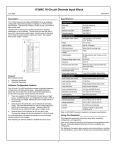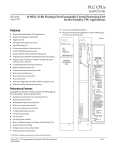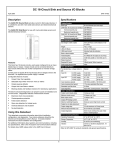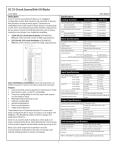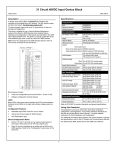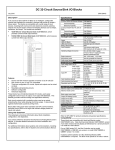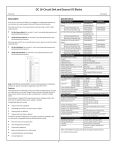Download Genius NEMA4 I/O Station, IC660BXD0022, GFK-0832
Transcript
I/OProducts NEMA4 I/O Station GFK–0832A June 1994 IC66*BXD022 The NEMA4 I/O Station consists of a 24 VDC Source I/O block installed in a rugged aluminum NEMA4 housing. The block is pre-wired to receptacles in the housing, for simple connection of field wiring. ÎÎ GENIUS Block Features 24/48 VDC Source In/Out GE Fanuc The block in the I/O Station can be used with 2–wire and 3–wire solid state sensors and electromechanical sensors. It has 16 discrete circuits, each easily configured to be an input, tristate input, or output. Output circuits can be connected directly to input circuits without the use of other components or inversion of logic states. The block’s LEDs verify proper block operation and CPU communications. Individual circuit LEDs on the logic side indicate voltage present on inputs and outputs. Housing Features The I/O Station’s NEMA4 housing provides a measure of protection against falling, splashed, and hose-directed water. It can be used indoors or outdoors. The block will not be damaged by the formation of ice on the housing. I/O connections to the block are made through the housing via Brad Harrison -style molded receptacles. Communications and power cables are installed via pass-through water-tight connectors. t The housing has a transparent window in the cover so the block’s LEDs can be seen. ÎÎ ÎÎ ÎÎÎÎÎ ÎÎ ÎÎÎÎ ÎÎÎ ÎÎ ÎÎ a45351 Using this Datasheet This datasheet describes installation of the I/O Station. It also briefly summarizes information about the operation, configuration, and diagnostics features of the I/O block. If you need more information about the I/O block, please see the Discrete and Analog Blocks User’s Manual (GEK-90486-2). For information about systems and communications, including bus specifications, refer to the System and Communications Manual (GEK-90486-1). 2 NEMA4 I/O Station GFK-0832A Mounting the I/O Station Equipment Required The illustration below shows: Quantity 4: #10 mounting screws H H H Mount the block in the orientation shown below. Drill screw or bolt holes for #10 hardware. Position the station so that the notches in the flanges line up with the mounting holes. Mount the block using #10 screws. Use star washers to provide ground integrity. overall dimensions of the I/O Station mounting hole spacing wiring clearances required from the side and bottom of the housing to a wall, panel, or other obstruction. a45353 Mounting Hole Spacing 7.31 in (185.7mm) Module Width 7.13 in (181.1mm) Module Height 10.13 in (257.3mm) Bottom Clearance 3.70 in (94mm) ÎÎÎÎÎ ÎÎÎÎÎ ÎÎÎÎÎ ÎÎÎÎÎ ÎÎÎÎÎ ÎÎÎÎÎ ÎÎÎÎÎ ÎÎÎÎÎ ÎÎÎÎÎ ÎÎÎÎÎ ÎÎÎÎÎ ÎÎÎÎÎ ÎÎÎÎÎ ÎÎÎÎÎ Î Î 5.50 in (139.70mm) Mounting Hole Spacing 8.88 in (225.6mm) Side Clearance 2.70 in (68.6mm) 4.28 in (108.7mm) NEMA4 16 Circuit DC Source I/O Block 3 GFK-0832A Power Connections Power and bus cables must be 0.25” to 0.375” in diameter. The power cable must include a ground wire, to bring chassis ground into the module. Three to six .250” x .032” female quick disconnects are required. Using two quick disconnects, attach the incoming power wires to the wiring board as shown below. Note: The I/O Station can be located on a bus stub downstream of another device that performs bus switching. It cannot be directly connected to a dual bus. Attach incoming +24V wire here COM +24V Power and Bus Connections Attach incoming common wire here Remove the housing cover to begin cable installation. Caution Pass the incoming serial bus and power cables through connectors SI and PI on the housing bottom. Connectors SO and PO can be used to daisy-chain the bus and/or power cable to another device. To use either of these connectors, first loosen the nut and remove the plug. ÎÎÎ a45352 Plug Caution Tighten the connector nuts firmly around all bus and power cables before completing the installation. GroundConnections Using a quick disconnect, attach the power cable ground wire to the ground terminal near the wiring board: Attach optional outgoing ground wire here Ground wire to I/O block Attach incoming ground wire here If you are daisy-chaining the power cable out to another device, connect the ground wire of the outgoing power cable to the remaining ground terminal. COM Attach outgoing +24V wire here Cable Installation +24V After installation, the housing cover must be firmly installed on the base. Recommended screw torque is 12 in/lbs. If you are daisy-chaining the power cable out to another device, connect the outgoing power wires. Attach outgoing common wire here Power Disconnects Wire external power disconnects so that block power and input power will be removed at the same time. Caution: If circuit power is not removed at the same time as block power, the block may power up when multiple inputs are activated, even though one leg of power has been removed from the block. Serial Bus Connections Connect the incoming serial bus to terminals 1 – 3 on the I/O block, as shown below. If there is also an outgoing bus cable, connect it to terminals 1, 2, and 4. Recommended torque for the terminal screws is 6 in/lb (.678N/M). ÎÎÎ ÎÎ ÎÎÎ ÎÎ ÎÎÎ ÎÎ ÎÎ ÎÎ ÎÎÎ ÎÎ Î 1 2 3 4 Serial Bus In SERIAL 1 SERIAL 2 SHIELD IN SHIELD OUT Optional Serial Bus Out If the station is at the end of the bus (no bus out cable), connect a terminating resistor of the appropriate type (see the System and Communications User’s Manual) across its Serial 1 and Serial 2 terminals. 4 NEMA4 I/O Station GFK-0832A Connecting I/O Devices First, remove the black wire from the In/Out terminal corresponding to the unused circuit. For example (if 9 were not used): Connect I/O devices to the Brad Harrison-style connectors in the side of the housing. Each connector can be used for an input or output. Note: To avoid possible contamination, leave covers on unused connectors. 7 remove black wire 9 IN/OUT COM N.C. +24V Wiring for Tristate Inputs If any input is configured as a Tristate Input, it will be necessary to install a 1.6K ohm resistor across that circuit’s input and +24 volt terminals (inside the housing). This added resistance is required to use the Open Wire diagnostic. The circuit LED will glow dimly. 5. Continue below for a dual output or input. For a Dual Output: Remove the brown wire (+ 24V) from the other terminal of the pair. Install it on the In/Out terminal where you removed the first black wire. Dual Input or Output Connection 7 Dual input and output devices require a simple change to the factory wiring inside the housing. A dual input or output device uses one connector in the housing, but counts as two circuits on the I/O block. For practical purposes, these two circuits should be located near each other on the wiring board (see the diagram at the bottom of the page). 9 IN/OUT COM N.C. 1. remove brown wire here +24V Install the first (black) wire you removed on the + 24V terminal where you removed the brown wire: 7 1. Be sure power to the I/O Station is OFF before proceeding. 9 IN/OUT COM N.C. replace black wire here 2. Decide on two circuits to use for the device. For example, 7 and 9. 3. Install the dual input or output device at the housing connector for either of the two selected circuits. Keep the connector for the other circuit covered. 2. replace brown wire here +24V For a Dual Input: Remove the white wire (No Connect) from the other terminal of the pair. Install it on the In/Out terminal where you removed the first black wire. Caution: Be sure no device is installed on the connector that corresponds to the other circuit of the pair. Unexpected operation would result. 7 4. On the wiring board, make the following changes. Note: Using long-nose pliers, grasp wires by the crimped terminal in the strain relief area ONLY. 9 2. replace white wire here IN/OUT COM N.C. 1. remove white wire here +24V 1 3 5 7 9 11 13 15 Terminals on the Wiring Board IN/OUT COM N.C. There are 4 terminals for each I/O circuit: In/Out, Common, No Connect, and +24V. +24V +24V All terminals in a row have the same function. For example, the In/Out terminals for even-numbered circuits 2 to 16 are in the same row. N.C. COM IN/OUT 2 4 6 8 10 12 14 16 NEMA4 16 Circuit DC Source I/O Block 5 GFK-0832A Install the first (black) wire you removed on the NC terminal where you removed the white wire. 7 replace black wire here 9 IN/OUT COM N.C. +24V 6 NEMA4 I/O Station GFK-0832A Block or Terminal Assembly Removal Inserting the Electronics Assembly The block’s Electronics Assembly can be removed and replaced without removing field wiring or reconfiguring the block. 1. Align the Electronics Assembly within the guides and push it down firmly. Caution If you remove the entire block, it will be necessary to remove the wiring and to reconfigure the block. Removing the Block’s Electronics Assembly Do not exert excessive force; it may damage the block. 1. Disconnect power to the I/O station and remove the housing cover. If unusual resistance is met, remove the Electronics Assembly. If power is applied to the block, DO NOT TOUCH THE CONNECTOR PINS! Inspect the Terminal Assembly, connector receptacle, and connector edge board (on the Electronics Assembly). Remove any obstacles and reinsert the Electronics Assembly. Pay close attention to the alignment of the guide pins. 2. Using a Phillips-head screwdriver, unscrew the Electronics Assembly retaining screws at the top and bottom of the block. Retaining screw for Electronics Assembly ÎÎ ÎÎ ÎÎÎÎ 2. Secure the Electronics Assembly with the retaining screws. (top of block) Removing the Block 3. Using the special I/O Station Block Puller , engage the tabs in the first vent slots. 1. Disconnect power to the I/O station and remove the housing cover. 2. Remove the wiring from the Terminal Assembly. 4. Pull the Electronics Assembly upward. 3. Using a Phillips-head screwdriver, unscrew the mounting screws at the top and bottom of the block. Vent Slots Retaining Screws (Qty. 2) Terminal Assembly Î Î Î Î Î Î Electronics Assembly Mounting screw ÎÎ ÎÎ ÎÎÎÎ (top of block) Connector Pins Warning If power is applied to the field terminals, power is also exposed on the connector pins at the base of the Terminal Assembly, and electrical shock hazard exists. Death or injury may result. 4. Carefully remove the block. Reverse the procedure to replace the block . After replacing the block, re-install the wiring. Wiring follows standard color code convention. The block must be reconfigured (see next page for a brief explanation) before it can operate on the communications bus. NEMA4 16 Circuit DC Source I/O Block 7 GFK-0832A I/O Block Information Summary Each circuit on the I/O block can be configured as an input, a tristate input, or an output. If the block is configured as a combination block, output feedback is provided via the corresponding input references. All output devices connect to the negative (–) side of the power supply. Inputs control the positive (+) side. A DC+ Configured as an Intput Input Device 75V A 1–16 I/O Configured as an Output " Smart Switch Processor * .1µfd LED 1200Ω A Terminal Assembly DC– Electronics Assembly 5.6K ohms for 24/48 VDC blocks. 1.8K ohms for 24 VDC blocks Circuit LEDs Each circuit has its own LED. If the circuit is configured as an input, the LED indicates the presence of threshold voltage at the input terminal. If the circuit is configured as an output, the LED indicates the actual state of the load. Diagnostics The block reports all faults to the Hand–held Monitor, and takes appropriate corrective action. H H H H H H Short Circuit Diagnostic (standard) Instantaneous current exceeds 10 amps at turn–on. Overtemperature Diagnostic (standard) Internal temperature exceeds 100º C. Failed Switch Diagnostic (standard) Output switch state is not the same as its commanded state.. May also indicate certain internal block faults. Open Wire Diagnostic (standard) Electrical (not mechanical) malfunction on a tristate input. Overload Diagnostic (configurable) No Load Diagnostic (configurable) Configuration The block must be configured with an HHM to: H H Warning – Explosion Hazard – DO NOT connect a Handheld Monitor to the block during operation in a CSA Class 1 Div 2 location. The features below can be configured from an HHM (see the Discrete and Analog Blocks User’s Manual for instructions) or the application program (as detailed in the System and Communications User’s Manual). Configurable Feature Output Device DC– Field Connections * DC+ In addition, unless all circuits on the block will be inputs, the Block I/O Type must be set to either Outputs or Combination on the Program Block ID screen. Enter its Block Number (serial bus address). Enter its Reference Number (required only for IC550 and IC600 series PLCs only). Circuit or Block Selection Factory Setting Block I/O Type B inputs, outputs, combination inputs Baud Rate B 153.6st,153.6ex, 76.8, 38.4 Kb 153.6st Pulse Test B enabled/disabled enabled Input Filter Time B 5–100mS 20mS Circuit I/O Type C input, output, tristate input input Report Faults C yes/no yes Hold Last State C yes/no no Output Def. State C on, off off Detect No Load C yes/no yes Overload S’down C yes/no yes BSM Present B yes/no no Outputs Def. Time B 2.5/10seconds 3 bus scans Redundancy Mode B none, duplex, standby, GMR none Duplex Default B on/off off Config. Protect B enabled/disabled disabled Note: If the block is configured offline, it must be properly grounded and have a 75W resistor installed across its Serial 1 and Serial 2 terminals. See the Discrete and Analog Blocks User’s Manual for instructions. Compatibility Any Hand–held Monitor can be used with the NEMA4 I/O Station. However, version IC66*HHM501 is required to change baud rate configuration, or to configure the block for redundancy. For an IC697 series PLC, the CPU and programming software must be version 2.0 or later. The bus controller must be IC697BEM731C or later. For an IC600 series PLC, the CPU must be rev. 105 or later. For an IC66* series Plus PLC, rev. 110 or later is required. The programming software must be rel. 4.02 or later. If the bus controller is model IC66*CBB900, it must be version C or later. For an IC550 series PLC, the CPU must be rev. 3.0 or later. The programming software must be rel. 2.01 or later. 8 NEMA4 I/O Station GFK-0832A I/O Station Specifications Catalog Numbers: NEMA4I/OStation IC66*BDX022 IC66*BBD022 IC66*TBD022 IC66*EBD020 24VDC Source 16 Circuit Source I/O Block Terminal Assembly only Electronics Assembly only I/O Station Size (height x width x depth) LEDS (block) LEDs (each circuit) Heat Dissipation Block to Block Isolation 10.13 in (257.3 mm) x 7.63 in (193.8 mm) x 5.50 in (139.7 mm) Unit OK, I/O Enabled Individual load side indicators tbd 1500 V Operating voltage Ripple (maximum) Required DC power Power supply dropout time Pass–through current 18–56 VDC (24/48 V), 18–30 VDC (24 V) 10% 150mAtypical/300mAmaximum 10mS 15 Amps, minus the power used by the I/O block and the devices connected to the I/OStation. Input Characteristics: For standard input, voltage relative to (DC–) Input ON: 16–24 VDC Input OFF: 0–7 VDC 5.6K ohms (24/48V), 1.8K ohms (24V) 1.7mS (plus selectable filter delay) 5–100mS Open wire, Overtemperature, Failed Switch Input processing time (typical) Input impedance (typical) Selectable input filter times Input diagnostics Output Characteristics: Output current (steady state) Maximum inrush current Block output current Output OFF leakage current Maximum switching frequency Output turn–on delay (maximum) Output voltage drop Minimum Recommended Load Output Diagnostics 2 amps per circuit 10 amps up to 10mS 15 amps at 35C 1.0 mA Once per second (high inrush current) 1mS 2.0 volts maximum at 2 amps inrush 50 mA with No Load nabled Short Circuit, Overload, No Load, Failed Switch, Overtemperature Environmental: Operating temperature Storage temperature Humidity Vibration tbd –40 to +100C (–40 to +212F) NEMA enclosure 5–10Hz 0.2” (5.08mm) displacement, 10–200Hz at 1G Temperature Derating The illustration below shows total load current versus temperature derating for the NEMA4 I/O Station. Total Station Load Current (Amps) 16 12 8 4 0 0 10 20 30 40 50 60 Operating Ambient Temperature: Degrees C









